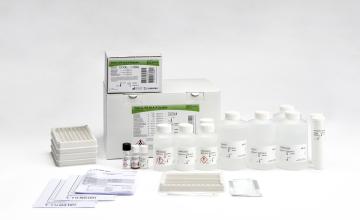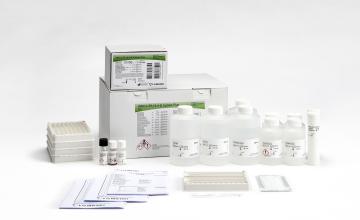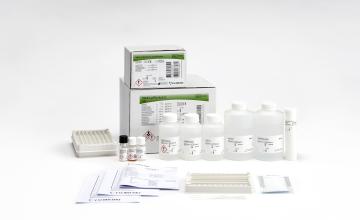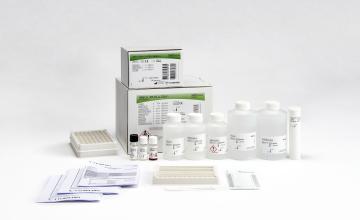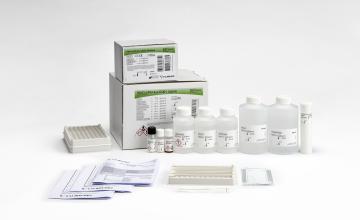HLA (Human Leukocyte Antigens) and Tissue Typing
HLA stands for human leukocyte antigens.
These are normal glycoproteins expressed to varying degrees on the surface of almost every cell in the body.
The molecules form part of the system of immune recognition, essentially the ability to distinguish "self" from "non-self".
Their role is to present peptides to cytotoxic T cells.
Specific destruction of non-self cells is induced when peptides derived from non-self or foreign antigens are presented.
The highest level of expression of these molecules is on white blood cells (leukocytes).
Classification of HLA
Molecules involved with HLA are divided into two groups - class I and class II.
Traditionally, classification into either group depended upon the distribution of the antigen among the cells of the body.
Class I antigens are ubiquitous, with the highest level of expression occurring on the T subset of lymphocytes.
Class II antigens have a restricted distribution, occurring only on the B subset of lymphocytes, macrophages, and other antigen-presenting cells.
Advances in X-ray crystallography and other methods of protein study have shown that class I and class II antigens can also be defined on the basis of their structure.
Class I
The class I molecules are composed of an alpha-chain stabilized by beta-2-microglobulin.
They play a crucial role in transplantation immunology and in the susceptibility to, or protection from, auto-immune or infectious diseases.
HLA class I antigens are further categorized as HLA-A, -B, and -C, according to the position of their encoding gene on the short arm of chromosome 6.
The HLA-A, -B, and -C loci are highly polymorphic; population surveys have identified over 850 class I alleles.
Class II
HLA class II antigens, which have a similar function to class I, are heterodimeric glycoproteins consisting of an alpha-chain and a beta-chain.
Class II antigens are further categorized as HLA-DR, -DQ, and -DP.
Again, this assignment depends upon the position of the encoding gene on the short arm of chromosome 6.
Both the DQ and DP regions contain one functional gene for each of their alpha and beta chains (DQA1 and DQB1; DPA1 and DPB1).
For HLA-DR, single separate genes code for the DR alpha-chain (DRA1) and the beta-chain (DRB1).
A DRB haplotype always contains a DRB1 allele, and, depending on the allele type, a DRB3, DRB4, or DRB5 may also be present, or may be accompanied by pseudogenes.
It is clear that the system of class II genes is quite complex!
The alpha-chain loci, DQA1 and DPA1, show limited polymorphism.
The beta-chain loci, however, are highly polymorphic.
Population surveys have identified over 580 class II alleles.
Most of the sequence diversity is localized on the second exon encoding the amino-terminal extracellular domain which functions as the peptide-binding groove formed by the alpha-beta chain heterodimer.
Importance of HLA
Tissue typing: Target indication and market potential
There are approximately 45 000 organ transplants performed in the United States and Europe each year and more than 160 000 individuals with end-stage organ failure are waiting for organ transplants.
The demand for transplant organs far surpasses the number of organs donated each year.
National and international organizations act as mediators between donors and recipients and play a key role in the acquisition and distribution of donor organs/bone marrow for transplant operations.
Data of all potential organ recipients, including blood group and tissue characteristics (HLA groups) are stored in a centralized computer database.
Subsequently, the patient is put on a waiting list.
As soon as a donor organ becomes available, the regional tissue-typing laboratory establishes the donor’s blood and tissue characteristics.
All relevant information about the donor is then passed on to the registration center where the patient is selected.
The HLA match is an important factor in this selection.
For bone marrow transplantation, the blood group and HLA type of all donors are also stored in a central database.
Currently, more than 8.8 million volunteer donors are registered worldwide.
Product profile
HLA typing has traditionally been performed using immunological markers.
However, this technique does not detect subtle differences between individuals.
In contrast, DNA-based typing can distinguish all known genetic differences (alleles) and can even detect previously unknown alleles.
This has led to an ever-increasing demand for DNA-based typing results.
INNO-LiPA products for HLA-typing of class I and class II
Fujirebio has developed and markets a complete line of HLA class I and class II products, that provide typing at the required level of resolution for solid organ transplantation and bone marrow transplantation.
The INNO-LiPA products for HLA-typing of class I (A, B, and C) and class II (DRB, DQB, and DPB) can be used with the automated processing system (Auto-LiPA 48) and the scanning and read-out software system (LiRAS®) for accurate interpretation of results.
Regular software updates incorporate newly described alleles.
Also, INNO-LiPA HLA products are regularly updated to constantly guarantee the best possible typing result.

